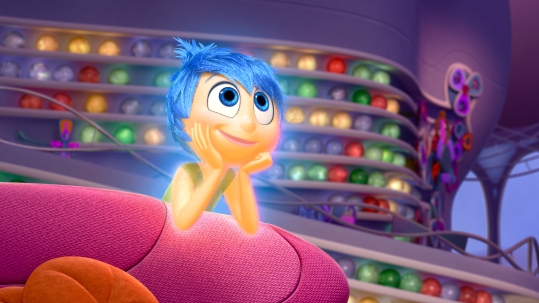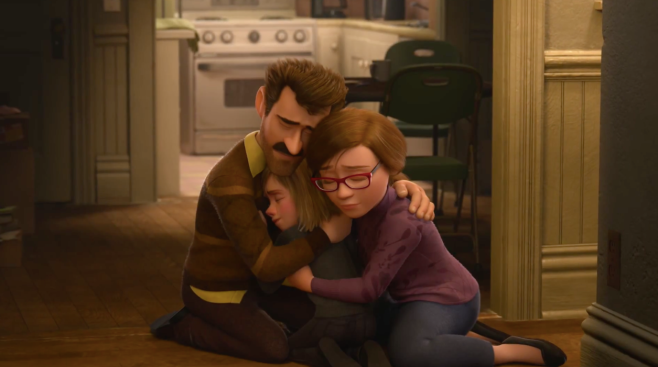One of my favorite stories to illustrate what sets Pixar apart from other animation studios comes from the summer of 2009, when my family found ourselves packed in a theater full of young parents with their children to see Pete Docter’s Up. We all know that within the first fifteen minutes, the main character faces the double tragedy of discovering his wife can not have children, followed by her death years later. On witnessing this famously depressing opening, a little kid sitting behind me loudly squeaked in near disbelief (and with a tinge of betrayal), “Mommy, this is sad.”
Most animated movies aren’t nearly as rawly emotional as Up and some of Pixar’s other classics. Parents are afraid of upsetting their children by exposing them to such supposedly-harmful emotions like ‘sadness’ and ‘loss’. I have experienced this tendency firsthand, as my mother intentionally kept my sister and I from watching Bambi as kids, feeling that the death of Bambi’s mother would be too upsetting for our fragile minds’ consumption. As the sheltering of kids from powerful negative emotions have grown widespread, modern cartoons have become largely bland, inoffensive, thematically simplistic affairs, often disproportionately focused on selling merchandise through a sickening concentration of generic cuteness. It’s gotten to the point where today’s most popular cartoon characters are lazily-designed yellow jelly beans that speak gibberish.
Though Dreamworks’ Minions won’t yet be out by the time I post this, I’d bet my life that the most emotional moments in that movie don’t scratch the least emotional ones in Docter’s new classic Inside Out, which itself tells the story of five emotions inside the head of an eleven year old girl named Riley. Inside Out is Docter’s response to every “mommy, this is sad,” his counterpoint to the mindless Minions, and his antidote for the stagnation that has gradually settled over animation since Toy Story 3. This movie proves its own thesis, that kids shouldn’t be sheltered from feeling the full range of emotions they have, Docter argues. And trust me, he doesn’t hold back.
Within minutes or maybe even second, Inside Out washed hooked me in so completely that I found myself having the same exact experience that I had getting utterly lost in the worlds of Monsters, Inc. and Finding Nemo as a kid. To watch Inside Out is to let yourself fall into the hands of the most masterful storytellers in the business. And though those storytellers are tackling the most ambitious concept the studio has ever attempted, they have built a world so incredibly genius, and explain the rules so efficiently and inventively, that I literally can’t imagine a moment in the first half hour (and very few over the course of the entirety of the movie) that could have been improved. This movie earns the audience’s complete and utter trust instantly.
Every little detail of this intricately-crafted universe simply makes sense. The five main emotions (Joy, Sadness, Anger, Fear and Disgust) sit at HQ and regulate their human’s emotional well-being. Memories arrive in an endless stream of orbs, each tinged with one of the five colors of the emotions. A yellow orb is a happy memory. A red orb is an angry memory. When memories fade, they turn black and are sent to a deep garbage dump forever. Dreams are produced in a movie studio which utilizes elements from that day’s memories. A ‘train of thought’ carries facts and opinions to and from. This all sounds rather abstract, but when viewing it laid out on screen, in simple yet incredibly vibrant color and colorful detail, it all works wonderfully.
Besides for a few small plot conveniences towards the end, the execution is just about perfect in every way. Editing is finely tuned to move between Riley’s mind and her external life for precise comedic and dramatic effect. Though I found Riley’s experiences a bit slight in comparison with the continuously ingenious ideas being thrown around inside her head, it still felt easy to care about her, even if not quite as much as Joy does. Riley was likely left a little bit void of specifics in order to allow any audience to attach themselves to certain elements they can relate to, my self included. For example, I was able to understand some of what she was going through since I also moved to a completely new place when I was eleven, not to mention that I’ll be making the same move from Midwest to California in the very near future. Anyone who has played a sport, had a busy father, or a strained friendship will be able to form a similar bond.
Though I would have liked to have seen all five emotions fully fleshed out, the focus is almost wholly on Joy and Sadness, with the others being static joke machines. After Joy and Sadness find themselves ejected far into the contents of Riley’s mind and they must journey back towards home base before the other three emotions send Riley spiraling into further emotional chaos. Even if the other three emotions get short thrift, all five are cast perfectly, with Poehler doing the greatest work overall. Complementing the vocal work is composer Michael Giacchino, who won an Oscar for Up and returns with yet another catchy score that is just as emotionally varied as the movie as a whole.
Inside Out is undeniably the most daring Pixar film ever made and among the studio’s best work, period. If you think that’s a bold claim, this also very well may be the most important family film ever made (while Where The Wild Things Are certainly beat it to the punch thematically, it is certainly nowhere near as accessible). Beyond just being entertaining — it is one of the downright funniest films Pixar has done — this is a crisp, clear tool for helping children understand and deal with powerful emotions while growing up. Further, it will likely be just as impactful in helping parents better talk to their children about their feelings and understanding that negative emotions can be just as useful to developing minds as positive ones. This is the true definition of a family film, one that serves society, both young and old, without being preachy and one that entertains without resorting to sensory overload or forced cuteness.
Oh, and did I mention that I teared up within fifteen minutes and can hardly even explain why? But trust me, that’s nothing compared to what’s coming. Up was a warm-up.
Score: 4.5 out of 5



